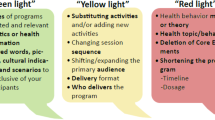Abstract
The effectiveness of advocacy has been well documented and its use established as a common practice in furthering sound public health policy and practices. Efforts are underway to explain how advocacy has supported, shaped and influenced public policy concerning – and the growth and development of – comprehensive cancer control initiatives. The objective of this paper is to assess the history, current role and future of advocacy as a means of articulating the value of, and furthering, comprehensive cancer control practices. Comprehensive cancer control is approaching a critical moment in its development, and a unified approach is necessary to achieve common goals. A call to action for supporting and contributing to the success of a comprehensive approach to cancer control is more important today than it was 11 years ago. Advocacy is an essential strategy in that call to action.
Similar content being viewed by others
References
Merriam-Webster’s Dictionary of Law (1996) Springfield, MA: Merriam-Webster, Inc.
The American Heritage Dictionary of the English Language (2000) 4th edn. http://www.bartleby.com/cgi-bin/texis/webinator/ahsearch? search_type=entry&query=advocacy&db=ahd&Submit=Search.
American Cancer Society (2004) The Importance of Advocacy Efforts in Reaching Our Goals, http://www.cancer.org/docroot/COM/content/div_ PA/COM_6_1x.
Susan G. Komen Foundation (2004) Komen Milestones, http://www.komen.org/intradoc_cgi/idc.
Abed, et al. (2000) Developing a framework for comprehensive cancer prevention and control in the United States: an initiative of the Centers for Disease Control and Prevention. J Public Health Manage Pract 6(2): 67–78.
See (5), above.
InstitutionalAuthorNameCenters for Disease Control and Prevention (2000) ArticleTitleImproving national cancer control Chronic Dis Notes Rep 13 IssueID3 1–23
Task Force on Community Preventive Services (2005) Systematic Review and Evidence Based Recommendations, http//www.thecommunityguide.org/about/default.htm.
US Department of Health and Human Services (2000) Reducing Tobacco Use: A Report of the Surgeon General. Atlanta, GA: Centers for Disease Control and Prevention, National Center for Chronic Disease Prevention and Health Promotion, Office on Smoking and Health.
InstitutionalAuthorNameCenters for Disease Control and Prevention (1994) ArticleTitleAttitudes toward smoking policies in eight states – United States 1993 Morbidity Mortality Rep 43 IssueID43 786–789
Global Strategy Group (2003) Survey of 800 Registered New York Voters. American Cancer Society, American Heart Association, New York City Coalition for A Smoke Free City, Campaign for Tobacco Free Kids, American Lung Association (Unpublished).
Campaign for Tobacco Free Kids (2005) About the Campaign: Who We Are, http://www.tobaccofreekids.org/organization.
American Nonsmokers Rights Foundation (2005) How Many Smoke Free Laws? http://www.no-smoke.org/pdf/mediaordlist.pdf.
Smoke Free Americas (2005) Resource Materials: Advocacy Tools, http://www.smokefreeamericas.org/resource_materialsadvocacytools_e.htm.
State of Delaware, Office of the Governor (2004) Delaware’s Smoking Rate Decreased by 11 Percent in 2003, http://www.state. de.us/governor/news/2004/07july/070204-smokingstudy.shtml and New York City Department of Finance, New York City Department of Health and Mental Hygiene, New York City Department of Small Business Services, and New York City Economic Development Corporation (2004) The State of Smoke-Free New York City: A One-Year Review, http://www.nyc.gov/html/doh/pdf/smoke/sfaa-2004report.pdf.
US Department of Health and Human Services (1999) Health effects of exposure to environmental tobacco smoke: the report of the California Environmental Protection Agency. In: Smoking and Tobacco Control Monograph, No. 10. Bethesda, MD: National Institutes of Health, Publication No. 99–4645.
American Heart Association (2005) Nation’s Top Health Groups Respond to 2005 Dietary Guidelines for Americans, http://www.americanheart.org/presenter.jhtml?identifier.
Personal Communication (2004) Stacy Thompkins, School Health Coordinator, Chronic Disease Directors Association.
Hellekson K, (2005) ACS/ADA/AHA Issue Core Recommendations for Preventing Cancer, Cardiovascular Disease, and Diabetes, American Family Physician, Practice Guidelines, http://www.aafp.org/afp/20050215/practice.html#p1.
American Diabetes Association (2005) Everyday Choices for a Healthier Life: Frequently Asked Questions, http://www.everydaychoices.org/aboutthisprogram.html.
Personal Communication (2005) Senior Advocacy Staff, American Cancer Society, American Diabetes Association, American Heart Association.
One Voice Against Cancer (2005) Fact Sheets, http://www.ovaconline.org/facts.html.
Centers for Disease Control and Prevention (2004) Cancer Prevention and Control, National Comprehensive Cancer Control Program, http://www.cdc.gov/cancer/ncccp/index.htm.
North Carolina Department of Health and Human Services (2001) The North Carolina Cancer Control Plan 2001–2006. Raleigh, NC: Advisory Committee on Cancer Coordination and Control, Cancer Prevention and Control Branch, pp. 6–342.
C-Change (2005) State Cancer Plans, http://www.ndoc.org/about_ndc/ndc_teams/state_cancer_plans.asp.
Author information
Authors and Affiliations
Corresponding author
Additional information
Steven L. Reynolds-The findings and conclusions in this report are those of the authors and do not necessarily represent the views of the Centers for Disease Control and Prevention.
Rights and permissions
About this article
Cite this article
Selig, W.K.D., Jenkins, K.L., Reynolds, S.L. et al. Examining Advocacy and Comprehensive Cancer Control. Cancer Causes Control 16 (Suppl 1), 61–68 (2005). https://doi.org/10.1007/s10552-005-0485-1
Received:
Accepted:
Issue Date:
DOI: https://doi.org/10.1007/s10552-005-0485-1




